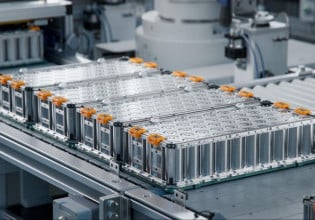How Can Electrification, Hydrogen Work Together?
A German study analyzes the application-specific opportunities of electrification and hydrogen deployment in Europe.
Using a combination of electricity directly in heat pumps and electric vehicles (EVs) and converting it to hydrogen for low-carbon fuels could be a promising strategy assisting the European Union’s goals to eliminate carbon emissions by 2050. That’s the principal finding of a study weighing the potential impacts of scaling up electrification and hydrogen to substitute fossil fuels in the industrial, building, and transport sectors.
A research team from the Potsdam Institute for Climate Impact Research (PIK) in Germany used a computational model to consider several transition pathways in the EU energy system. They found two strategies for coupling the power sector with other energy-heavy applications: prioritizing “direct electrification” for passenger vehicles and low-temperature heating and “indirect electrification” through hydrogen and synthetic fuel conversion for chemical, shipping, aviation, and electricity storage industries.
Solar panels and a wind turbine. Image used courtesy of Pexels
The growing uptake of wind and solar resources in Europe’s power sector underpins these findings, with renewable electricity rising from 14% in 1990 to 38% in 2020. Renewables support the EU’s 2030 target to reduce emissions by 55% (compared to 1990) and achieve greenhouse gas neutrality by 2050. Still, non-electric energy use in buildings, transport, and industrial applications remains largely dependent on fossil fuels.
A breakdown of the final energy (FE) share of electrification (direct) and hydrogen (indirect electrification) by scenario. Image used courtesy of the study’s authors (Figure 1)
Across the modeled scenarios, electricity and hydrogen-based fuels could make up 73-78% of the final energy required across the EU’s 27 member states by 2050. Direct electrification could be the dominant strategy, growing from a 20% share of total energy consumption in 2020 to 42-60% by 2050. Indirect electricity may amount to 9% to 26% for hydrogen-based energy used in hard-to-electrify sectors, such as chemical production and long-distance transport.
Meanwhile, EU electricity demand is expected to increase by 80% to 160% by mid-century, generating 5,200 to 7,300 TWh annually. This growth comes with significant variable renewable energy and integration requirements. Between 2025 and 2050, Europe is projected to add an annual capacity of 60 to 110 GW of solar photovoltaics and 40 to 60 GW of wind power. The intermittent nature of both resources creates challenges for Europe’s power grid as the region continues to phase out fossil fuel resources that generate power on demand to cover renewable volatility.
Direct Electrification: EVs and Low-Temperature Heating
The study, published recently in One Earth, defines direct electrification as switching to electric end-use technologies such as battery EVs (BEVs), on-site electric heat pumps, and resistive electric heating in buildings and industrial facilities.
Europe is already scaling up these applications. The REPowerEU plan aims to add 60 million new heat pumps by 2030, up from about 20 million installations today. The EU also banned the sale of conventional internal combustion engine (ICE) cars by 2035. Direct electrification is best suited for passenger cars and low-temperature heating. Both applications are aligned with the EU’s energy transition plan.
Combining electrification with a hydrogen-focused strategy can meet the needs of long-distance trucking and industrial processes that utilize some hydrogen, like non-metallic minerals. The remaining industrial sectors, such as non-ferrous metals, pulp and paper, food, and machinery, could achieve high levels of electrification with heat pumps or resistive heating, which generate low to medium temperatures.
Electricity demand across scenarios (A) and sectors (B), including transmission losses and energy system consumption. Image used courtesy of the study’s authors (Figure 4)
The study calls for expanding renewables and switching to electric technologies where possible, which is the cheapest and fastest way to eliminate carbon emissions in most sectors. Policymakers could push an end-use transformation toward direct electrification while prioritizing hydrogen and synthetic fuels that partially utilize existing infrastructure and applications.
Indirect Electrification: Hydrogen and Synthetic Fuels
The PIK researchers define indirect electrification as converting electricity to hydrogen or low-carbon synthetic fuels for ICE cars or gas boilers. It can also support alternative end-use technologies like hydrogen-based steel-making and fuel cells.
The EU's demand for hydrogen-based energy carriers will hit 1,000 to 2,600 TWh annually by 2050. About 500 TWh of that total includes synthetic fuels used as non-fossil carbonaceous energy carriers for chemical production and long-distance transport, such as shipping and aviation.
Despite strong demand, indirect electrification comes with a few challenges. Unlike electricity, which is increasingly available and energy-efficient, the conversion to hydrogen and synthetic fuels (and the combustion of both) produces significant energy losses. Green hydrogen production also requires electrolysis, a low-carbon alternative to now-dominant natural gas- or coal-based processes. Electrolysis capacity is currently low in the EU at less than 10 TWh annually. The EU must quickly expand its electrolytic hydrogen supply without diverting significant renewable energy from higher-efficiency electrification.
Hydrogen and synthetic fuel demand across scenarios (A) and sectors (B). Image used courtesy of the study’s authors (Figure 3)
Transporting hydrogen is another barrier, requiring expensive imports by ship or distribution infrastructure via hydrogen pipelines with extensive regulatory planning and long construction timelines.
The PIK researchers suggested scaling up hydrogen supply chains by incentivizing electrolytic hydrogen use with different pricing strategies capitalizing on variable renewable energy, meaning using wind and solar in hours when the supply is abundant and electricity prices are low.



_share.jpg)






